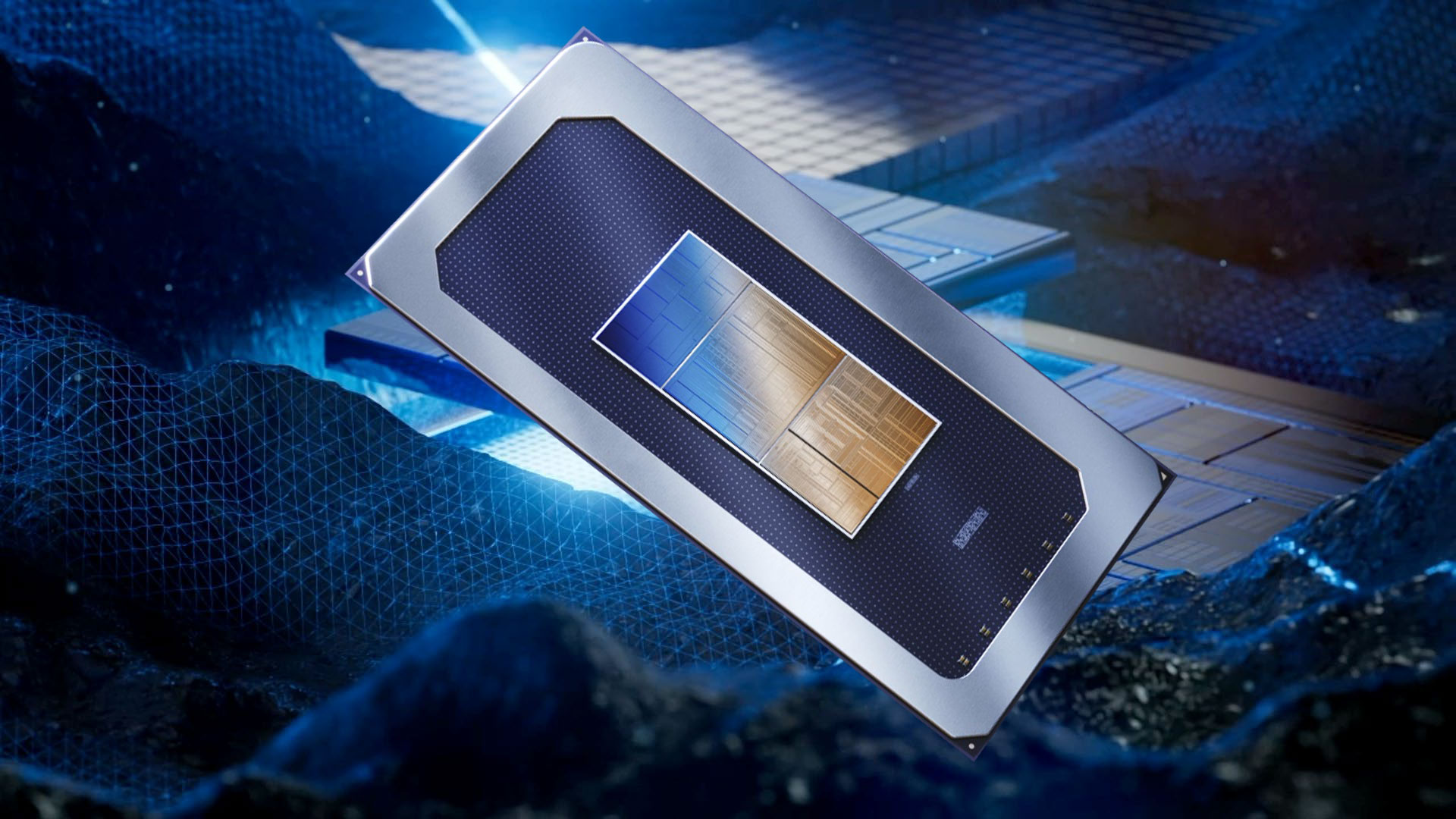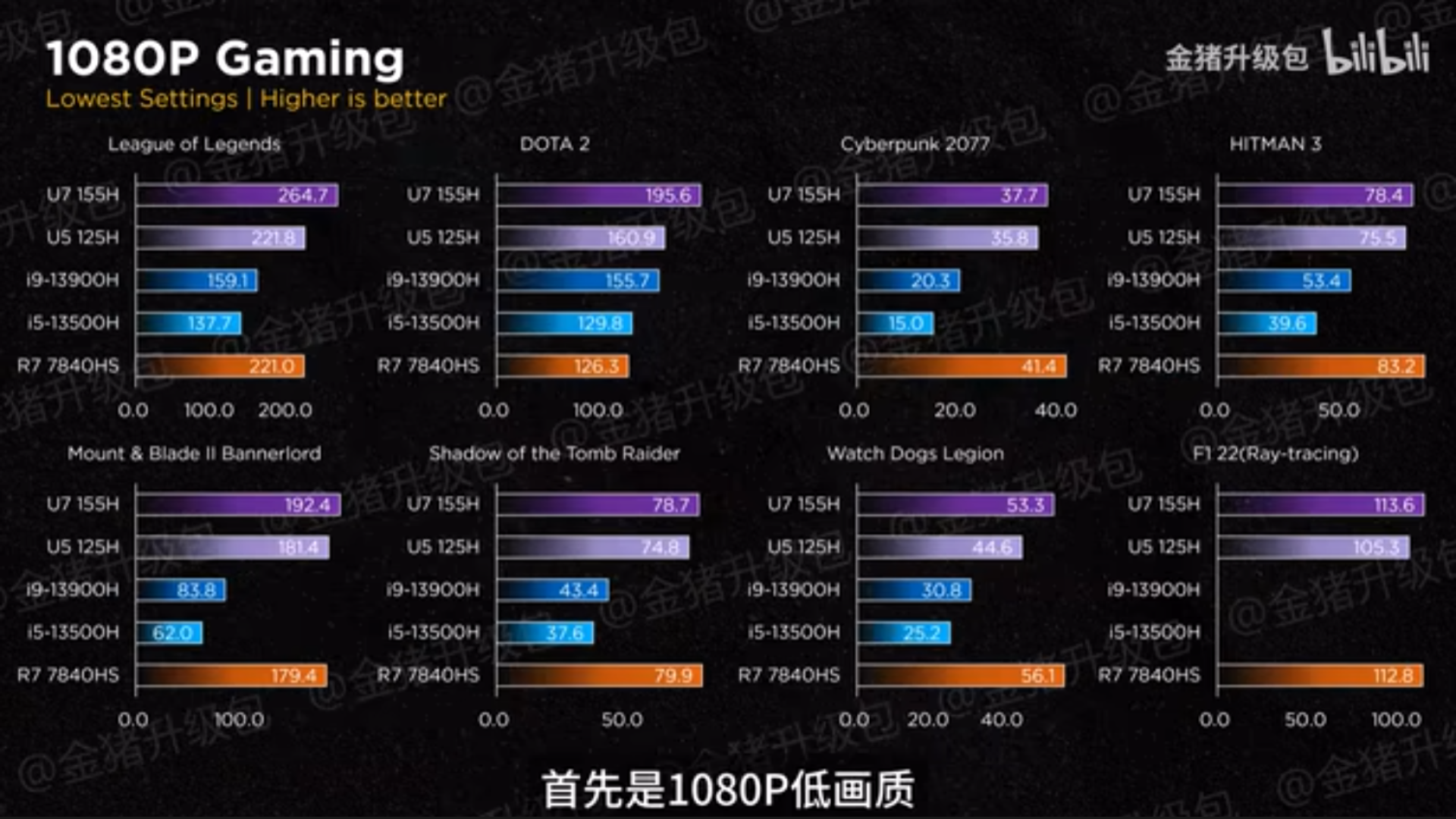Intel may have finally caught up to AMD in iGPU performance — Meteor Lake's Arc iGPU edges out AMD Phoenix's RDNA 3 iGPU in gaming and synthetic benchmarks
AMD may no longer be the iGPU king in the mobile space, while the desktop space remains to be seen.

Intel's brand-new Meteor Lake CPUs might find a niche as powerful gaming processors thanks to their powerful integrated graphics. In a review by Golden Pig Upgrade, the Core Ultra 7 155H could barely overtake AMD's Ryzen 7 7840HS in gaming and synthetic iGPU benchmarks. It's the first time AMD has lost its lead in integrated graphics since 2019.
Meteor Lake CPUs use a combination of chiplets (or tiles as Intel calls them) to make a complete processor, and this has allowed Intel to equip high-end Meteor Lake chips with a massive integrated GPU. With 128 execution units, this graphics chip is 50% larger than Intel's integrated graphics in Tiger Lake, Alder Lake, and Raptor Lake. Meteor Lake uses the newer Xe-LPG architecture instead of Xe-LP, which is quite old.
In Golden Pig Upgrade's review at 1080p low settings, the Core Ultra 7 155H beat the Ryzen 7 7840HS in four of eight games. That's technically a tie. But Intel's Core Ultra 7 155H had some genuinely massive leads in League of Legends and Dota 2. Things weren't too different at 1080p high settings, though the Core Ultra 7 155H's performance dropped significantly in Hitman 3. But it could be a bug, considering that even the Core i9-13900H was faster than the Core Ultra 7 155H in Hitman 3 at high settings.
The Core Ultra 7 155H's lead in 3DMark's synthetic graphics benchmarks was much higher than in real games, though, with the margin ranging from 25% to nearly 40% in Intel's favor. That could indicate that Meteor Lake's iGPU has more raw horsepower that actual games aren't taking advantage of. However, it's unclear whether newer drivers could extract that extra performance or if 3DMark is particularly sensitive to the Core Ultra 7 155H's quad-channel memory configuration.
Power efficiency is also in Intel's favor, sort of. In League of Legends, the Core Ultra 7 155H and Core Ultra 5 125H had better efficiency than the Ryzen 7 7840HS, though not considerable. However, efficiency will significantly depend on TDP, as the two Meteor Lake chips are only more efficient than the Ryzen 7 7840HS with a power consumption of 30 watts or more. At 15 watts, the Ryzen 7 7840HX was about 30% more efficient than the Core Ultra 7 155H, and that probably means Meteor Lake won't be the processor of choice for handheld gaming PCs like the Steam Deck and ROG Ally.
Meteor Lake is probably Intel's best showing in integrated graphics since Ice Lake for laptops in late 2019. However, then, Intel was competing with old Zen+ APUs in the Ryzen 3000 series, and Ice Lake quickly lost the crown to Ryzen 4000 APUs with the Zen 2 architecture and a reworked iGPU in early 2020. This time, Intel is going up against AMD's latest RDNA 3 architecture, and it's just barely clinched a victory.
Get Tom's Hardware's best news and in-depth reviews, straight to your inbox.

Matthew Connatser is a freelancing writer for Tom's Hardware US. He writes articles about CPUs, GPUs, SSDs, and computers in general.
-
Bikki To say the Intel iGPU win AMD iGPU on those games is not correct. If you was following game benchmarking then you know LoL, Dota 2, Mount & Blade are one of those titles that are cpu bounded. Intel chip wining here is not surprising given raptor lake already had higher single thread cpu performance.Reply
To be fair, Intel is finally getting real close to AMD in term of performance, but not surpassing them just yet. -
Roland Of Gilead I don't know. IMO Intel have done a good job here. As history tells us, Intel's iGPU have been rubbish over the years. We all know that. This time around the iGPU is more akin to AMD's APU's level iGPU. Certainly now close in performance. Arc release wasn't bad either. I think this bodes well for the general consumer, who will have better battery life, along with half decent gaming in a nice Thermal envelope (not currently). The only downside is the shared ram/vram. Still, it's a good show.Reply -
abufrejoval AMD started a competition there, where they aren't well positioned to win any more, now that Intel has caught up.Reply
When AMD split their chips into CCDs and IODs for a far more efficient way to produce a large range of desktop and server chips, that obviously caught Intel offguard.
But that flexibility was lost on the APU side, where AMD for the longest time and almost systematically today only has a single physical die.
Sure, producing different designs in different process sizes has given them some leeway, but they still basically don't have a response to Intel's far more fine-grained mix-and-match chips cookery. And they surely can't just multiply their engineering teams to match Intel's size.
Intel can now produce a vast variety of product across a giant range of performance, efficiency and price points, most of which won't actually be necessary, but bargain hunting consumers just revel in choices, little matter if they are meaningful or not. And it's worst case when Intel can claim the top performer in each variant.
AMD will only be able to hit a few of these spots and for lack of 50% performance gaps in any of those main categories of performance, efficiency or price), vendors will most likely go with an Intel design that allows them to cover the entire range. With so many (somewhat artificially inflated) choices to deal from Intel, where is the motivation and gain to deal with AMD offers? AMD just can't afford contra revenues like team Blue to bribe vendors.
Unless AMD has a Foveros 2 hidden in their labs, I am afraid that AMD's only choice is to go with design much like Apples M series, APUs that can be aggregated in S, M, L using 1/2/4 APU slices with fixed core, GPU, cache and RAM channel allocations. I'd still want one external RAM channel allowed for CPU RAM expansion, though, because I can rarely have enough RAM.
P.S. I am also worried that consoler makers are eying Intel with far more interest today... -
fla56 Reply
AMD is literally 30% more efficient at power levels that mater for laptopsRoland Of Gilead said:I don't know. IMO Intel have done a good job here. As history tells us, Intel's iGPU have been rubbish over the years. We all know that. This time around the iGPU is more akin to AMD's APU's level iGPU. Certainly now close in performance. Arc release wasn't bad either. I think this bodes well for the general consumer, who will have better battery life, along with half decent gaming in a nice Thermal envelope (not currently). The only downside is the shared ram/vram. Still, it's a good show.
Unless you are claiming people buy Intel iGPUs to game at 50W? -
fla56 Reply
Is this post parody / comedy?abufrejoval said:AMD started a competition there, where they aren't well positioned to win any more, now that Intel has caught up.
When AMD split their chips into CCDs and IODs for a far more efficient way to produce a large range of desktop and server chips, that obviously caught Intel offguard.
But that flexibility was lost on the APU side, where AMD for the longest time and almost systematically today only has a single physical die.
Sure, producing different designs in different process sizes has given them some leeway, but they still basically don't have a response to Intel's far more fine-grained mix-and-match chips cookery. And they surely can't just multiply their engineering teams to match Intel's size.
Intel can now produce a vast variety of product across a giant range of performance, efficiency and price points, most of which won't actually be necessary, but bargain hunting consumers just revel in choices, little matter if they are meaningful or not. And it's worst case when Intel can claim the top performer in each variant.
AMD will only be able to hit a few of these spots and for lack of 50% performance gaps in any of those main categories of performance, efficiency or price), vendors will most likely go with an Intel design that allows them to cover the entire range. With so many (somewhat artificially inflated) choices to deal from Intel, where is the motivation and gain to deal with AMD offers? AMD just can't afford contra revenues like team Blue to bribe vendors.
Unless AMD has a Foveros 2 hidden in their labs, I am afraid that AMD's only choice is to go with design much like Apples M series, APUs that can be aggregated in S, M, L using 1/2/4 APU slices with fixed core, GPU, cache and RAM channel allocations. I'd still want one external RAM channel allowed for CPU RAM expansion, though, because I can rarely have enough RAM.
P.S. I am also worried that consoler makers are eying Intel with far more interest today...
Which console maker will be buying this chip exactly?
Which gamers are buying Intel to game at 50W exactly? -
gilgamex101 Reply
AMD is enormous nowadays compared to where it used to be at its peak down-and-out era of Late Phenom II' into the FX Chip line nightmare, poor Bulldozer...... In any case, they have tremendous market share and are in almost every console, if not AMD, then ARM. They have built in-roads, business relationships, trust and a very interdependent connection over support of all kinds. They are extremely competitive, and AMD's graphics division is no slouch whatsoever. While Nvidia is far and away the leader of all 3 in that department, there is a push towards more open source technologies, I feel. An inevitable trend towards open source especially in light of manufacturing process delays which have been a complete nightmare for Intel over the last couple of years. Delays after delays, hardly inspires confidence. They tried the low power notebook market, netbooks, tablets, you name it. They crashed out hard, not that they might not return one day. I just personally think proprietary hedgemons are going to find themselves with increasing stiff competition moving forward. RISC-V anyone?abufrejoval said:AMD started a competition there, where they aren't well positioned to win any more, now that Intel has caught up.
When AMD split their chips into CCDs and IODs for a far more efficient way to produce a large range of desktop and server chips, that obviously caught Intel offguard.
But that flexibility was lost on the APU side, where AMD for the longest time and almost systematically today only has a single physical die.
Sure, producing different designs in different process sizes has given them some leeway, but they still basically don't have a response to Intel's far more fine-grained mix-and-match chips cookery. And they surely can't just multiply their engineering teams to match Intel's size.
Intel can now produce a vast variety of product across a giant range of performance, efficiency and price points, most of which won't actually be necessary, but bargain hunting consumers just revel in choices, little matter if they are meaningful or not. And it's worst case when Intel can claim the top performer in each variant.
AMD will only be able to hit a few of these spots and for lack of 50% performance gaps in any of those main categories of performance, efficiency or price), vendors will most likely go with an Intel design that allows them to cover the entire range. With so many (somewhat artificially inflated) choices to deal from Intel, where is the motivation and gain to deal with AMD offers? AMD just can't afford contra revenues like team Blue to bribe vendors.
Unless AMD has a Foveros 2 hidden in their labs, I am afraid that AMD's only choice is to go with design much like Apples M series, APUs that can be aggregated in S, M, L using 1/2/4 APU slices with fixed core, GPU, cache and RAM channel allocations. I'd still want one external RAM channel allowed for CPU RAM expansion, though, because I can rarely have enough RAM.
P.S. I am also worried that consoler makers are eying Intel with far more interest today... -
brandonjclark "In a review by Golden Pig Upgrade, the Core Ultra 7 155H could barely overtake AMD's Ryzen 7 7840HS in gaming and synthetic iGPU benchmarks."Reply
To say, "could barely overtake" is poor phrasing. It implies that the Intel product had a position to defend when in fact the AMD product was the one defending the position.
A better editorial phrase choice would be, "was able to barely overtake".
In this sense, "was able to" implies that a new feat was accomplished. -
abufrejoval Replyfla56 said:Is this post parody / comedy?
Which console maker will be buying this chip exactly?
Which gamers are buying Intel to game at 50W exactly?
AMD can currently offer pretty much cut & paste at chip design time--for the entire ASIC.
The ability to create bespoke designs for console makers with CPU, GPU, NPU, VPU and AI blocks of any size is attractive to console makers, who want to hit a very specific price/performance point for their products.
That was a lot of flexibility and it won Sony and Microsoft.
But what if you want several products? Or if you want to adapt to the market mid-generation?
With Foveros the cut & paste capabilities move a lot nearer to the assembly time, a much later integration point with lower hurdles for change. The barrier to variations is much lower.
It obviously all depends on the cost of Foveros vs. a single chip design, but that may not be a static cost, too many engineers at Intel are working on lowering that barrier for that.
Intel is betting the company on being able to create much more fine grained chip assemblies for a far wider range of products than AMD.
AMD is currently executing at the die carrier level and they do their V-cache stuff, but those are two rather specific use cases that do not cover the personal computing range very much.
They better have something up their sleve! -
GoldenBullet For igpu, the upscaling abilities is key for the best gameplay experience. Unless Intel has something as good as amd and Nvidia, amd is still the clear winner.Reply -
D1v1n3D Reply
But there is a new Gen well half a Gen that is coming very very soon this will be a mild upgrade but when things get even smaller more kinds of combo chiplets designed to do specific tasks will fit under the same space the 5to 7nm chiplets lay then adding AMD 3d stacking tech Amd seems to be ready to launch some crazy stuff but why when what is out there now is outselling Intel all day long lately I bet there are some top secret chips in design and testing phases that may never make it to market for one reason or another. Like a lot of big engineer teams that break off into a few different teams have three different directions and the best one of the three makes it the other two for whatever reason don't see the light of day for now at least.Admin said:Intel's Core Ultra Meteor Lake CPUs have seemingly dethroned AMD's Ryzen 7040 Phoenix APUs in integrated graphics.
Intel may have finally caught up to AMD in iGPU performance — Meteor Lake's Arc iGPU edges out AMD Phoenix's RDNA 3 iGPU in gaming and synthetic be... : Read more
